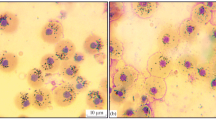Summary
-
1.
Graded erythrocythemia was induced by isovolemic loading of packed red blood cells in the toad,Bufo marinus. Blood viscosity, hematocrit, hemoglobin concentration, maximal aortic blood flow rate and maximal rates of oxygen consumption were determined after each load.
-
2.
Blood viscosity was related to hematocrit in the expected exponential manner; ln η=0.43+0.035 Hct (Fig. 2).
-
3.
Maximal blood flow rates in the dorsal aorta were inversely proportional to blood viscosity and fit predictions of the Poiseuille-Hagen flow formula (Fig. 3). The effect of increased blood viscosity was to reduce aortic pulse volume, but not maximal heart rate (Figs. 4, 5).
-
4.
Maximal systemic oxygen transport capacity (aortic blood flow rate x hemoglobin concentration x O2 binding capacity of hemoglobin) was linearly correlated with the maximal rate of oxygen consumption (Fig. 6).
-
5.
These data indicate that optimal hematocrit theory is applicable for maximal blood flow rates in vivo, and that systemic oxygen transport is the primary limitation to aerial \(\dot V_{O_2 } \) max in amphibians.
Similar content being viewed by others
References
Crowell JW, Smith EE (1967) Determinant of the optimal hematocrit. J Appl Physiol 22:501–504
Gahlenbeck H, Bartels H (1968) Temperaturadaptation der Sauerstoffaffinität des Blutes vonRana esculenta. Z Vergl Physiol 59:232–240
Hillman SS (1976) Cardiovascular correlates of maximal oxygen consumption rates in anuran amphibians. J Comp Physiol 109:199–207
Hillman SS (1980) The effect of anemia on metabolic performance in the frog,Rana pipiens. J Exp Zool 211:107–111
Hillman SS (1982) Effects of DL-propranolol on exercise heart rate and maximal rates of oxygen consumption inScaphiopus intermontanus. Experientia 38:940–941
Hillman SS, Withers PC (1979) An analysis of respiratory surface area as a limit to activity metabolism in anurans. Can J Zool 57:2100–2105
Hillman SS, Shoemaker VH, Putnam R, Withers PC (1979) Reassessment of acrobic metabolism in amphibians during activity. J Comp Physiol 129:309–313
Langille BL, Jones DR (1977) Dynamics of blood flow through the hearts and arterial systems of anuran amphibians. J Exp Biol 68:1–17
Lipowsky HH, Usami S, Chien S (1980) In vivo measurements of “apparent viscosity’ and microvessel hematocrit in the mesentary of the cat. Microvasc Res 19:297–319
Miller K, Hutchison VH (1980) Aerobic and anaerobic scope for activity in the giant toad,Bufo marinus. Physiol Zool 53:170–175
Murray JF, Gold P, Johnson BL (1962) Systemic oxygen transport in induced normovolemic anemia and polycythemia vera. Am J Physiol 230:720–724
Pavek K, Carey JS (1974) Hemodynamics and oxygen availability during isovolemic hemodilution. Am J Physiol 226:1172–1177
Richardson TQ, Guyton AC (1959) Effects of polycythemia and anemia on cardiac output and other circulatory functions. Am J Physiol 197:167–1170
Seymour RS (1973) Physiological correlates of forced activity and burrowing in the spadefoot toad,Scaphiopus hammondi. Copeia 1973:103–115
Shelton G (1970) The effects of lung ventilation on blood flow to the lungs and body of the amphibian,Xenopus laevis. Respir Physiol 9:183–196
Snyder GK (1971) Influence of temperature and hematocrit on blood viscosity. Am J Physiol 220:913–918
Weathers WW (1976a) Influence of temperature on the optimal hematocrit of the bullfrog (Rana catesbeiana). J Comp Physiol 105:173–184
Weathers WW (1976b) Influence of temperature acclimation on oxygen consumption, haemodynamics and oxygen transport in bullfrogs. Aust J Zool 24:321–330
Wells RE, Denton R, Merrill EW (1961) Measurement of viscosity of biologic fluids by cone plate viscometer. J Lab Clin Med 57:646–656
Withers PC, Hillman SS (1983) The effects of hypoxia on pulmonary function and maximal rates of oxygen consumption in two anuran amphibians. J Comp Physiol 152:125–129
Author information
Authors and Affiliations
Rights and permissions
About this article
Cite this article
Hillman, S.S., Withers, P.C., Hedrick, M.S. et al. The effects of erythrocythemia on blood viscosity, maximal systemic oxygen transport capacity and maximal rates of oxygen consumption in an amphibian. J Comp Physiol B 155, 577–581 (1985). https://doi.org/10.1007/BF00694447
Accepted:
Issue Date:
DOI: https://doi.org/10.1007/BF00694447




